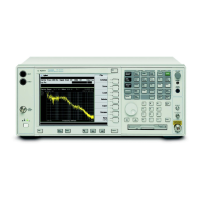To select the default disk
1
Press [
Disk Utility
] [
DEFAULT DISK
].
or
Press [
Save/Recall
] [
DEFAULT DISK
].
2 Press [
NON-VOL RAM DISK
]
or
Press [
VOLATILE RAM DISK
]
or
Press [
INTERNAL DISK
]
or
Press [
EXTERNAL DISK
].
Your default disk selection tells the analyzer which disk to use when it is saving and
recalling files. You can use online help to learn more about these options, but here is
an overview:
• [
NON-VOL RAM DISK
] selects the analyzer’s battery-backed RAM disk. There is
approximately 100 Kbytes of storage space for data. (Option UFF adds an
additional 1 Mbytes of non-volatile RAM.) The data is not lost when you turn off
the analyzer.
• [
VOLATILE RAM DISK
] selects the analyzer’s volatile RAM disk. Data is lost when
you turn off the analyzer. However, you can format the disk to hold more data than
the non-volatile RAM disk, and file operations are much faster than on the internal
disk.
• [
INTERNAL DISK
] selects the analyzer’s internal disk drive. The internal disk uses
3.5-inch flexible disks (double-sided, double- or high-density). For more
information, see “To format a flexible disk” later in this book.
• [
EXTERNAL DISK
] selects an external GPIB disk. (You must specify a disk unit
number with the [
EXTERNAL DISK UNIT
] softkey.) Enter the address of the disk
drive in the [
Local/GPIB
] menu with the [
DISK ADDRESS
] softkey. The analyzer
must be set as the [
SYSTEM CONTROLLER
]. For more information on setting
addresses, see online help.
Setting Up Agilent 35670A Quick Start Guide
16
